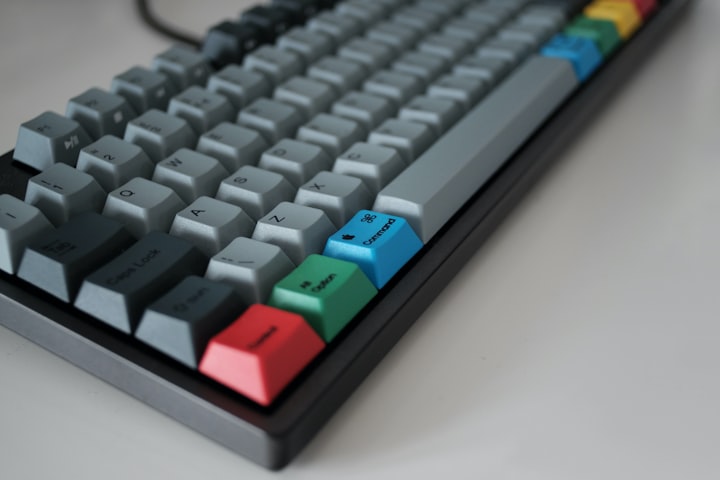The Delete Button Triggers My OCD
Stop Editing During Writing to Stop Writer's Block

Looking at a blank page is terrifying. Writing the first line is paralyzing. Rereading a paragraph sparks doubt, anxiety and stifles the flow of new ideas. Editing during the creative process is a writer’s greatest handicap, at least mine. My best stories are written in my mind when I sleep or when I am lathering my hair in the shower. When I force myself to pull the blanket tighter around my body or increase the water temperature and remain in a calming environment, ideas flourish producing story lines that Hemingway would envy.
However, attempts to write in the shower produce soggy paper and the ink-dyed soap stings my eyes. Writing in bed requires me to shed the comforter and expose myself to the self-criticism from which I hide. So, I force my body to sit at the desk in front of my laptop attempting to record stories that flittered through my mind when my brain rested, when Queen Mab deposited inspiration and creative juices weaved between dreams, musings, and conscious thought.
Perfectionism can be the enemy
Words stall and efforts are fleeting as my perfectionism distracts me from composition and plunges me into the details of editing. The obvious remedy requires me to silence the voices in my head that constantly correct the passive voice, align verb agreement, clarify ambiguity, and incessantly suggest a better way to phrase the obvious without overstating the simple while reminding me to add vivid details in a genuine voice. (There are a lot of voices screaming in my head when I write.)
They say once you identify the problem, the solution is not far behind. They (whoever they are) lied. Until I can allow the creativity to flow uncensored onto the page, placing words on paper will be like taking one step forward and two back in my attempt to attain grammatical perfection instead of stylistic prose.
Writing is a process
Writers must embrace the belief that writing is a process. A final draft does not just appear on paper. In fact, great writers attest that many drafts must be written, massaged, and revised before the final product can be published.
And the first stage of the process is creation. With words trapped in my head, I have been forced to drastic measures to get the ideas on paper before I can sabotage my own success. For instance, many years ago, stores sold a product called carbon paper. (If you remember, then you are as old as me.) When this magical fabric was placed between two pieces of paper, the words scribed on the top page would be transferred to the bottom page. The carbon paper served as a page of ink that, when pressed upon, transferred the writing to the next. I found success writing when I wrote with a sharp point on the top paper (no ink). This process forced me to write without being able to read what I produced. The focus was on the production not the product. I didn’t read my words until I unveiled them. It was refreshing to not self-censor. However, to my knowledge carbon paper is a thing of the past, relegated to reside beside mimeograph machines and typewriters in museums.
Writer’s block is a traffic jam in the mind. My problem when stuck does not stem from writer’s block. Self-censoring doesn’t block the flow of ideas it works more like a traffic jam during rush hour. All the ideas are speeding through my head in an attempt to connect with the paper but a car pulls out in front of me going 20 miles an hour under the speed limit, there is a fender bender in the medium, and everyone is craning their neck to see what happened. My mind swerves to avoid the distractions but I become sidetracked by road signs that all seem to contradict each other: slow, stop, curve ahead, no U-turn, caution, speed limit reduced, and no stopping.
As the driver of the car, you see the destination ahead, but it is unattainable because of the traffic, construction, detours, and speed traps. In the same manner, I visualize the final draft in my head but once I begin writing, the process becomes interrupted. I am a distracted writer. My first draft often becomes stalled and placed off to the side when confronted with the detours of editing.
Addressing distracted writing
Thus, the question plagues me (and probably other writers who are afflicted with distracted writing), “How can I record the words on paper without constant intrusion: editing and revision? How do I silence the voices who point out the flaws?”
I tried taking the backspace and delete buttons off my computer thinking this would allow me to keep moving forward but discovered just because the caps are removed, the tasks can still be performed. The back button on the computer may be the most destructive tool ever provided to a writer. Just the knowledge that a light press erases flaws keeps me from moving forward with a narrative. (Again, one step forward and two back.)
In the new age (one without carbon paper), I dim the light on my computer screen forcing myself to type words I cannot see, forcing me to record the story without the opportunity of editing. Then when the light comes on (literally, I turn the screen light on), I have my moment of truth. Figuratively, I am enlightened by my thoughts. And then the revision and editing can begin.
Ultimately, I have had to learn to write without gimmicks and control my impulses to revise and edit.
I have learned writers must learn to accept the disorder to gain understanding.
I have had to accept; writers must write with fluidity and continuously increase the word count on the page because a writer must create before they can correct.
As Jodi Picoult wrote, “You might not write well every day, but you can always edit a bad page. You can’t edit a blank page.”
About the Creator
Brenda Mahler
Travel
Writing Lessons
Memoirs
Poetry
Books AVAILABLE ON AMAZON.
* Lockers Speak: Voices from America's Youth
* Understanding the Power Not Yet shares Kari’s story following a stroke at 33.
* Live a Satisfying Life By Doing it Doggy Style explains how humans can life to the fullest.






Comments
There are no comments for this story
Be the first to respond and start the conversation.